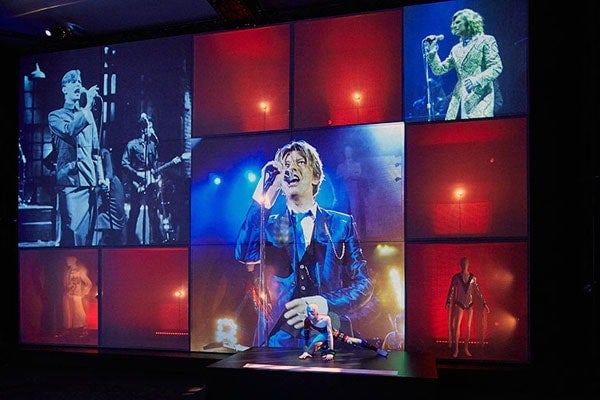
David Bowie: why he matters
Published: October 29, 2013
The Art Gallery of Ontario is the latest stop of the successful David Bowie exhibition that originated at London’s Victoria and Albert Museum. It’s prompted a resurgence of interest in the theatrical musician.
Writer Jenny Hall spoke to Professor Ken McLeod of the Faculty of Music and the Department of Arts, Culture and Media at U of T Scarborough about Bowie’s impact and influence.
David Bowie’s career has spanned five decades, and he’s made music in so many different genres. What’s your take?
I think that’s one of the reasons we appreciate Bowie. He’s a 21st century Renaissance man. And it’s not just music. Even though he’s been involved in many different styles of music—and in generating different styles of music—I think we have to look at his involvement in acting, computer gaming, children’s programming, even. Though there’s a lot of emphasis on his almost chameleon-like musical personae, it goes beyond just the music.
 You said he was responsible for generating genres? Which ones?
You said he was responsible for generating genres? Which ones?
I think if you look at what made him most famous, it’s his glam rock/Ziggy Stardust persona. (See a replica of the quilted bodysuit David Bowie wore for the Ziggy Stardust album cover at right.)
He really did innovate a certain theatricality, and the notion of creating a character. Where he’s innovating is more in the realm of image and the creation of these personas, rather than musical innovation per se. He’s a very good musician, but there are very few artists that are actually musically innovative. Bowie’s most innovative music is probably the stuff that we didn’t really hear because it wasn’t commercially successful. For example, his 1995 album Outside is really interesting from a musical perspective
Can you talk a little more about these personas he inhabits? Often he acted like the “character” even in the real world. Sometimes it seemed like it was going beyond just playing a character.
It’s a performance. He’s playing around with the concept of life as performance. Bowie is a performance artist. It probably gets blurry, even for him, but I don’t know that it’s about him inhabiting that character as much as it is about projection, about performance. I think to a large degree, he’s an actor as much as anything. That’s what makes him interesting, and that’s why he’s innovative. He drew attention to the artificiality of popular music—of celebrity culture, too. It’s conscious artificiality.
 It seems like a lot of Bowie’s success and/or controversy was about his purposeful androgyny.
It seems like a lot of Bowie’s success and/or controversy was about his purposeful androgyny.
Absolutely. He’s not the first person to do this. Little Richard comes to mind: he overtly manifested an androgynous stage persona.
Again, I think there’s something about the theatricality of Bowie that made him have more of an impact. It was an overt androgyny. To some extent that links into the whole glam rock project. The music can be aggressively masculine, but also complex and subtle in perhaps a feminine way. There’s almost an androgyny to the music as well. It’s not heavy metal; it’s not progressive rock.
Bowie is known for his glam rock period and his 1980s hits. Do most people know what he’s done since then?
They don’t. In the 1980s he put the Thin White Duke and all the personas and all the theatricality of the 1970s aside, and became a mainstream pop performer. He had the mega hit Let’s Dance, and did the world tours.
Then he kind of retrenched. He fell off the mainstream radar. In 1988 he formed Tin Machine. Starting around the Tin Machine era, his work became less about himself as a visual character. It became more musically adventurous, but at the same time he alienated himself from his previous mainstream rock and roll success.
His 1995 album Outside was industrial, electronic music. He also took a turn toward alternative rock. And in the late 1990s and into the 2000s, he’s became an experimentalist. He doesn’t seem as interested in commercial success. Even the title of the album Outside is telling. He began as an outsider: the persona that he was projecting was of the outsider, the alien. It became a bit predictable, and it became kind of a cliché that he was going to reinvent his personas. And of course other people were jumping on that bandwagon—Madonna comes to mind. Then he became very much an insider—a rock star. Then back to being outside the mainstream again.
However, I note that there been a resurgence of popularity of Bowie lately based around a few things. Certainly in Canada we’ve noticed his association with Arcade Fire. That has made Bowie hip again. It was a seal of approval for both of them. The other thing is the Chris Hadfield’s “Space Oddity” remake from the international space station. And of course there’s the museum exhibition, side by side with Bowie’s new album. There are these weird confluences that brought Bowie back as a contemporary figure who has something meaningful to say to us again.
What do you consider the message of Bowie’s music and performance?
A lot of it is about the realization that you can be anybody you want to be. We put people in boxes, but you don’t have to be in a box. You can reinvent yourself. That’s very liberating. You don’t have to be one thing or one persona or one character your entire life. You can do whatever you want. It’s an extension of Shakespeare: all the world’s a stage, and all the men and women merely players on it.



